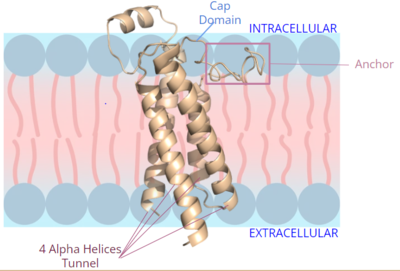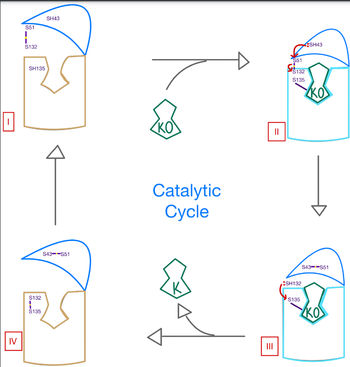Sandbox Reserved 1709
From Proteopedia
IntroductionBiological Role of VKOR(VKOR) is an enzyme that, as its name implies, promotes the reduction of (KO). VKOR is a transmembrane protein spanning the endoplasmic reticulum and composed of 4 transmembrane helical proteins. One of its primary roles is to assist in blood coagulation by regenerating hydroquinone (KH2). KH2 acts as a γ-carboxylase cofactor that drives the γ-carboxylation of several coagulation factors. Structural characterization of VKOR has been difficult, though, due to its in vitro instability. Nonetheless, a near perfect atomic structure has been determined utilization anticoagulant stabilization and VKOR-like homologs. Author's NotesAs previously mentioned, the VKOR structure has been challenging to qualify. Thus it is important to note that to date all VKOR structures discovered were done so from 2 methods. First, crystal structures of Human VKOR were captured with a bound substrate (KO) or vitamin K antagonist (VKA). VKA substrates utilized were anticoagulants, namely Warfarin, brodifacoum, phenindione, and chlorophacinone. Second, VKOR-like homologs, specifically isolated from the pufferfish Takifugu rubripes, aided in structure classification as well. Structural HighlightsStructural OverviewVKOR has many key components of its structure that allow it to maintain proper functionality and catalytic abilities. The VKOR active site allows for specific substrate binding via many highly conserved residues that can recognize the target substrates. It works in conjunction with the cap domain, which is a helical component of the VKOR that facilitates the conformation from the open to closed conformation of the enzyme once the substrate binds. Interactions between this domain, the active site, and the bound protein are critical to achieve full activation of Vitamin K. Another important part of the structure is the anchor, which simply serves as a way to hold VKOR within the proper orientation in the cell membrane such that all enzymatic components are in correct proximity for substrate binding and catalysis. Active SiteWithin the four transmembrane helices lies the . The active site is comprised of a hydrophobic pocket containing two hydrophilic residues, A80 and Y139, that interact with substrates and ligands alike. The hydrophobic pocket provides specificity to the region while the hydrophilic residues have potential to hydrogen bond, allowing recognition and increasing specificity as well. Slightly above the active site is a crucial disulfide bridge that provides stabilization when a substrate is bound. This bridge occurs between C132 and C135, recurrent residues that continually aid in VKOR function. The active site plays a vital role in binding of any substrate or ligand to the VKOR. Upon binding, the VKOR will transition into a that will allow its catalytic mechanism to commence. Cap DomainA key part of VKOR is the function of the , which is located right above the helices of VKOR towards the intracellular part of the membrane. The cap has a helical shape and is located in close proximity to two other domains: the Anchor domain and beta hairpin. This combination of domains help to maintain the proper orientation in the membrane. The cap domain assists with activating Vitamin K as it induces the structural change of VKOR from the open conformation to the closed conformation upon substrate binding. Cap rearrangement and transition to the closed conformation initiates a domino effect through the catalytic mechanism. The cap domain has critical interactions that stabilize the closed conformation including a between C43 and C51, and polar interactions from D44. These interactions are broken up by reactive cysteines to induce different conformations and help facilitate this transition from the open conformation to the closed conformation during the activation of Vitamin K. AnchorThe is a key part of the VKOR structure and function that protrudes from the side of VKOR with the primary role of stabilizing the enzyme within the membrane. It sits on top of the membrane surface, as shown in figure 2, such that anchor residues can interact with the cell membrane to maintain proper proximity for VKOR activity. To accomplish this, hydrophilic residues are positioned to interact with the outer hydrophilic leaflet of the bilipid membrane, while the hydrophobic residues on the anchor have strong interactions with the inner hydrophobic leaflet of the bilipid membrane. These interactions allow for VKOR to remain in the proper membrane arrangement and proximity for Vitamin K to bind and be activated via the cap domain and active site. The anchor also serves a role in connecting the cap domain to the rest of the membrane so that it stabilizes its covering of the central binding pocket to keep the substrate within the active site during its catalytic activation. These membrane interactions allow for VKOR to stabilize in the membrane for proper activation of Vitamin K and catalytic function of the enzyme. Function: Method of CoagulationBrief OverviewThe will be prepped and waiting for a substrate or ligand to bind. Once the substrate binds, this will induce the of VKOR, where the catalytic mechanism will activate Vitamin K via reactive cysteine residues. Vitamin K will then be released from the binding pocket once it is fully activated for use in the body, and VKOR will resume the open conformation once again. The enzyme will then reset into its reactive state to prep for another molecule of Vitamin K to bind.
Catalytic MechanismThe catalytic mechanism of VKOR is highly regulated and uses reactive catalytic cysteines to activate Vitamin K TO INSERT PRECISE CHEMICAL TERMS. The enzyme begins in in the open conformation with the cap domain open to allow substrate binding. Once a substrate binds, the cap domain transitions to the closed conformation. VKOR is now in . To stabilize the substrate bound closed conformation, the cap domain helps initiate a catalytic reaction of cysteines to break the disulfide bridge that was stabilizing stage 1. Free cysteines are now available that provide strong stabilization of the closed conformation through interactions with the cap domain and the bound substrate. This puts the enzyme in , where the catalytic free cysteines react to form a new disulfide bridge, releasing the activated product into the blood stream to promote anticoagulation. With two stable disulfide bridges and VKOR unbound, the enzyme is now in its final, unreactive . VKOR must undergo conformational changes to return to Stage 1 and restart the catalytic process to activate Vitamin K again. Disease and TreatmentAfflictionsSince activated Vitamin K plays a crucial role in blood coagulation, defects in the function and enzymatic activity of VKOR may detrimentally effect on Vitamin K's ability to promote blood clotting. Mutations in VKOR also increase susceptibility to vascular diseases, such as a stroke [1]. Vitamin K is also important in maintaining bone health with inactivity of VKOR linked to decreased bone density and osteoporosis [2]. InhibitionThe most inexpensive and common way to treat blood clotting is through the VKOR inhibitor, . Warfarin is able to do so by outcompeting KO, such that Vitamin K cannot be activated to promote coagulation in the blood. Warfarin will enter the binding pocket of VKOR, creating strong hydrogen bonds with the active site. Warfarin resistance may also occur due to mutations of VKOR, decreasing the effective anticoagulation some drugs may be attempting to promote. The degree of resistance is important to determine so that warfarin may be an effective anticoagulant without being detrimentally effective in blood flow. MutationsSome key that can be detrimental to the VKOR structure are mutations of the . The two main residues, N80 and Y139, can be mutated to A80 and F139 creating a decrease in recognition and stabilization.
| ||||||||||||
References
1. Elshaikh, A. O., Shah, L., Joy Mathew, C., Lee, R., Jose, M. T., & Cancarevic, I. "Influence of Vitamin K on Bone Mineral Density and Osteoporosis" (2020) Cureus, 12(10), e10816. [1]
2. Guomin Shen, Weidong Cui, Qing Cao, Meng Gao, Hongli Liu, Gaigai Su, Michael L. Gross, Weikai Li. The catalytic mechanism of vitamin K epoxide reduction in a cellular environment. (2021) Journal of Biological Chemistry, Volume 296,100145. https://doi.org/10.1074/jbc.RA120.015401.
3. Li, Weikai et al. “Structure of a bacterial homologue of vitamin K epoxide reductase.” Nature vol. 463,7280 (2010): 507-12. doi:10.1038/nature08720.
4. Liu S, Li S, Shen G, Sukumar N, Krezel AM, Li W. Structural basis of antagonizing the vitamin K catalytic cycle for anticoagulation. Science. 2021 Jan 1;371(6524):eabc5667. doi: 10.1126/science.abc5667. Epub 2020 Nov 5. PMID: 33154105; PMCID: PMC7946407.
5. Yang W., et. al. “VKORC1 Haplotypes Are Associated With Arterial Vascular Diseases (Stroke, Coronary Heart Disease, and Aortic Dissection)” (2006) Circulation. ;113:1615–1621 [2]



